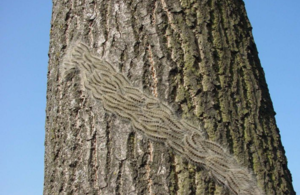Forestry Commission takes action to manage oak tree pest
Operational zones updated to manage spread of Oak Processionary Moth pest.

Oak Processionary Moth on a tree [Credit: Forestry Commission]
The Forestry Commission is today (8 March) updating the operational zones and boundaries to manage the spread of Oak Processionary Moth (OPM).
OPM caterpillars and their nests contain hairs which can cause itchy rashes, eye and throat irritations, and should not be touched under any circumstances. OPM caterpillars feed on oak leaves and can increase trees’ vulnerability to attack by other pests and diseases, making them less able to withstand adverse weather conditions, such as drought and floods. The greatest human and animal health risk period is May to July when the caterpillars emerge and feed before pupating into adult moths.
As The OPM season begins in March when the caterpillars can start to emerge. To coincide with this, changes to the three operational boundaries of the management zones – Area designated free from the pest, Buffer Zone, and Established Area – will be implemented to continue to help to restrict the spread of the pest.
In response to government surveillance in 2022, the Established Area in which OPM is established, and the Buffer Zone in which an annual programme of OPM management led by the Forestry Commission takes place, will be expanded. This will be implemented to limit the spread of OPM into the rest of the UK which is designated free from the pest.
Trade and local authorities should check the updated zones and boundaries on GOV.UK and the OPM resource hub to establish which zone they are in from 08 March 2023 onwards.
Andrew Hoppit, Oak Processionary Moth Project Manager, said:
Oak processionary moth larvae can cause significant damage to oak trees and pose a risk to human and animal health. These new measures are designed to minimise the spread and impact of the pest and protect our precious oak trees, as part of our wider tree health protection regime.
Any sightings should be reported to the Forestry Commission via our TreeAlert portal
First identified in England 2006, the pest is now present in London and surrounding counties. OPM management varies across England to reflect the known distribution of the pest and to protect uninfected areas. A Government programme to manage OPM has been in place since 2012 to control its spread and reduce pest prevalence, undertaken by the Forestry Commission.
Landowners, the public, and trade are urged to remain vigilant for the pest and report any sightings to the Forestry Commission via our TreeAlert portal, by emailing opm@forestrycommission.gov.uk or calling 0300 067 4442.
Later this year, new regulation will come into force that will permit the movement of large oak trees within the OPM Buffer Zone and Established Area, provided specific biosecurity and movement measures are met. Any Professional Operators in the Buffer Zone or Established area for 2023 should speak to their Plant Health and Seeds Inspector (PHSI) now to discuss biosecurity requirements including what they need to do to prepare.
For more information, visit ‘Managing Oak Processionary Moth in England’.
ENDS
Further information on support for those affected by Oak Processionary Moth:
- The OPM Groups Grant funds the surveying of oak trees within local communities in London and the South East, supporting efforts to better understand the risks and appropriate management of OPM. To ease the administrative process and encourage cooperative action in local communities, it pays for a lead facilitator to form a group of local landowners who all need support to tackle the pest. This builds on existing support and guidance available to help minimise the impact and spread of the pest.
- The OPM Private Residents’ Pilot supports private residents with small numbers of oak trees to help with the treatment of oak.
- A toolkit for local authorities and larger landowners to help plan for and manage OPM has been developed by the Tree Council, in partnership with Forest Research.
Wider background:
- Following possible OPM contact, visit your pharmacist for relief from milder skin or eye irritations. Consult a GP or call NHS111 for more serious reactions. Contact a vet if animals are seriously affected.
An interactive map showing the locations of confirmed reports of OPM in 2021